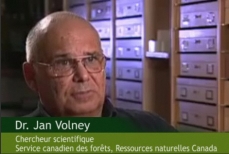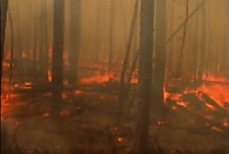Transcription of video clip 3.2.4
Boreal forest regeneration: fire is good for the forest

© Canadian Forest Service, Natural Resources Canada
Le Dr. Jan Volney
There’s a myth about the boreal forest that it’s like a cathedral, it doesn’t change.
But in fact, because it’s a living community of living organisms, several species involved, there’s this constant change going on.
The boreal forest is a disturbance-driven forest, so the business of having disturbance for renewal is tremendously important.
This allows other trees to populate and thrive in the boreal forest.
And so this constant process of renewal and death is a characteristic of this disturbance that we see so common in the boreal forest.
It structures the forest, and this diversity itself supports biodiversity.

© Canadian Forest Service, Natural Resources Canada
A forest fire
A natural disturbance : fire!
Fire is good in the boreal forest.
It rejuvenates the forest.
It’s part of the natural processes.

© Canadian Forest Service, Natural Resources Canada
Dr. Martin Alexander, Senior Fire Behaviour Research Officer, Canadian Forest Service
Well, fire in the boreal forest has multiple roles.
First of all, it affects the forest vegetation, its structure and composition.
In turn, that would influence wildlife habitat patterns and populations, as well as forest insects and pathogens.
Jack pine and lodgepole pine are probably the most classic examples.
Their seed is stored in cones that are only released when they are exposed to the flame and heat from a forest fire.
And, because the seed it released, then it starts a new forest.
From a standpoint of the interaction between fire and wildlife, a good example of something that’s beneficial to wildlife would be the case of moose.
They’re dependant on young aspen forest, and older aspen forests are just not accessible as a food source.
So, when a fire burns through an aspen forest, it starts a process of sprouts, young sprouts, that are accessible as food now for the moose.
This disturbance is integral to the boreal forest.
Many of these stands are so young that they never get past a certain age, under the earth.
Some of them last on the landscape for a very long time.
So what you want to do is maintain that balance.
But the thought that these stands will stay in this condition forever is a myth.
It doesn’t happen.
Back to video clip




